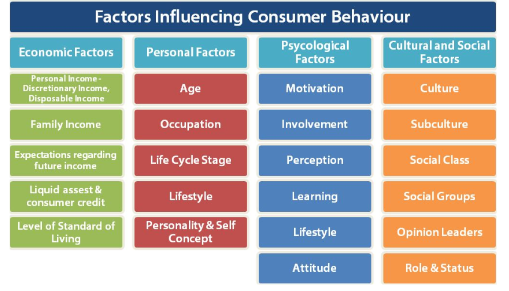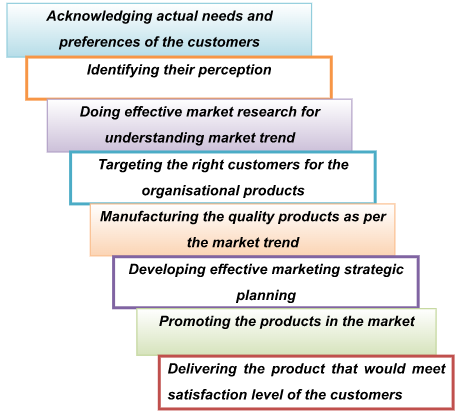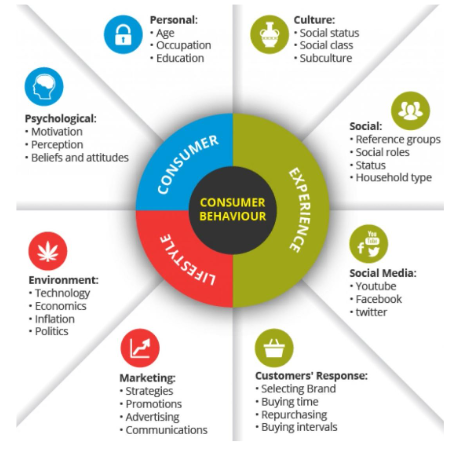Introduction
Product specification
Consumer behaviour is mainly a study of a group of individuals with the activities of purchasing, decision making behaviour, utilisation of the products and disposal of the good and services associated with the consumer’s mental, psychographic, demographic and geographic behaviour (Reed Et al., 2012). The aim of the study is to understand the concept of identify and self of the customers which have great impacts on the buying behaviour of the customers. There are demographic, psychographic and personal factors that influence the customers to make effective purchase decision. Through this study it is also possible to analyse the impacts of the concept of self and identify in consumer behaviour on the market researchers and practitioners in developing effective marketing tactics for the organisations in near future.
Concept of identity and self in the context of consumer behaviour
The customer’s identity is a patter through which the individual can describe themselves where as per the culture of the people, people no longer consumer the goods and services if their satisfaction level are not maximised. As per the social identity, people’s activities and possessions are organised as per their social identity such as aggressiveness or honesty. Roles of the person in the society such as accountant, parent, manager or athletes mainly describes the behaviour of the customers and hereby, social identity has great influence on the consumer’s purchase behaviour and intention of consuming one particular product or service (Toth, 2014).
Gender identity is the second one where the behaviour of the customer differs according to their genders. The social behaviour and consumption patter also differs as per the genders of the consumers. Ethnicity is another factor in case of identity of the customers where the consumers make effective purchase decision as per their cultural background. In this regard, the customer identity is one of the crucial factor having great impacts on the brands. Hereby, as per the identity of the customers, the possessions, self concept and psychological needs are created and the organisations try to analyse the identity of the customers before offering the organisational products and services.
Personality is mainly the psychological characteristics of the people that determines and reflects how an individual responds with his or her environment. As per the theory of Freudian, there are three factors, Id, super ego and ego. ID is related to physiological needs of the people which seek satisfaction after consuming the product or service. Super ego is the internal expression of socio cultural forces and ethics of codes which also have impacts on the consumer buying decision making practice. In addition to these, ego is where the individual tries to balance his or her impulsive needs and social cultural constraints (Hamilton, and Hassan, 2008).
For understanding the needs of the buyers and convert them to the customers for the company is the main strategy of the companies where they try to understand consumer behaviour for offering the right products and services as per the needs and preferences of the consumers. Personality of the buyers mainly signifies the psychological characteristics of the customers that further reflect how the consumer reacts as per their external and internal environment. Personality shows the perspective of the customers in choosing the products and services and it helps the marketers to promote the brand and offer the right products and services to the right customers where the purchase intention of the consumers is high. Personality of the individual is helpful for categorising the traits, likes, dislikes, perceptions and their satisfaction level (Solomon et al., 2014).
Self concept defines the preferences, beliefs, attitude and opinion of the customers which is a systematic manner for making effective purchase decision. Self concept is helpful to understand he psychology, trait abilities and preferences of an individual which are important to analyse the purchase intention of the customers. In this regard, trait theory is effective to understand the self and personality of the customers.

Through Trait theory, it is possible how the customers are innovative and their nature to chooser innovative products in the market. Additionally, materialism is another factor through which it is possible to emphasise on acquiring and owning products. Through self-consciousness, it is easy to demonstrate whether the person is able to monitor and control his or her consumption pattern. Need for cognition is where the people like to identify the information related to products and services or the organisation to make effective purchase decision. Frugality is when the individual is willing to purchase the products for resourceful use not for short term use. Through this theory, it is possible to understand the perception of the customers in making effective purchase decision.

As per the figure above, it is possible to identify the factors that have crucial impacts on the identity and self of the customers which in turn helps to make effective purchase decision. The economic factor is among those where the income level of the customers and expectation regarding future income as well as level of standard of living, liquid asset and customer credit are important for the customers to make effective decision for purchase. For example, if the customers is well established and he or she has effective liquid asset as well as moderate standard of living, he or she can afford long term investment for a branded product or service so that it is possible to utilise the products or services resourcefully for long run. On the other hand, personal factors are important where age, occupation, life style, self and personality of the customers are considered. In this regard, by age of the customers, his or her perception towards choosing a particular product is different.
Psychological factors are also crucial which includes attitude, innovativeness, motivation, perception and involvement of the customers. In this regard, the customers make effective purchase decision which can meet their psychological needs so that the products and service that they buy can meet the satisfaction level of the customers. If the customers are willing to take risk and go for more innovation, the latest upgraded products and technology will attract those customers though the price is high. On the other hand, the cultural and social factors also matters, where culture of the consumers, social role and status, opinion and social class matters in order to make effective purchase decision. Hereby, the self and identity of the customers play a crucial role in influencing the purchase decision making behaviour of the customers (Foxall, 2014).
Evaluating usefulness of the concept for marketing researchers and practitioners

As the above figure, the market researcher and practitioners have the opportunity to gather effective information about the perception of the customers in the market. Targeting the right customers or the organisational products is also another benefit where the brands can retain the customers for their quality products. Through acknowledging the actual needs and preferences of the customers, the company can develop proper marketing tactics and promote the products at effective market so that it is easy to strengthen the customer’s base (Marin, Ruiz and Rubio, 2009).

The customer’s behaviour depends on the psychological and personal factors such as age, occupation, motivation, beliefs and attitude. Through understanding the personal and psychological background of the customers, it is possible to deliver the right product to the right customers. For example, Nike as a famous sport apparel organisation targets the people aged between 18 to 35 years where they are involved with sports so that it is possible to promote their shoes and encourage the people for living healthy life and boosting energy. Additionally, perception and beliefs of the consumer plays a significant role which influence the people to make effective purchase decision. For example, Apple has strong brand image in the electronics manufacturing industry. The individual who prefer Apple’s Smartphone, laptops and Mac book, make effective purchase decision though the price of the product is much higher as compared to other electronics product manufacturing companies in the market such as Samsung, Blackberry, Lenovo, HP, Dell etc. Hereby, it can be stated that, the perception and beliefs of the customers is important factor that influence the purchase behaviour of the customers. The consumers who prefer innovation and creativity, they also prefer the innovative products of Apple for meeting their needs and satisfying them.

On the other hand, self and identify including social identify is important factor for influencing the purchase behaviour of the customers. Economic situation and income level of the customers have crucial impacts on the decision making behaviour of the customers (Zeugner-Roth, Žabkar and Diamantopoulos, 2015). For example, self and identity analysis in the context of consumer’s behaviour is beneficial for Apple as it targets the high income earners in the society, who can afford their products and services. Moreover, for example, Zara is a high fashion brand and in this regard the market research is helpful for the researchers to identify the people who like fashionable clothing and latest design so that they can purchase unique fashionable outfit. In this regard, the price of the company’s products is also high and the market research will help Zara to target the high income earners and the individuals who like fashionable clothing. Zara also targets the fashion industry and develop effective marketing strategies for promoting their products successfully.
Market research for customer’s behaviour is also helpful for understanding themselves through acknowledging their purchase time, buying intervals, repurchasing behaviour and brand selection. This information also provides an opportunity to the market researchers and practitioners to develop proper perception regarding the customers and in this regard the collected data is beneficial for the company to retain the consumers gain and stay connected with them for maximising business aims and objectives. Through this collected information, the market researchers try to provide authentic data to the company for developing effective promotional tactic and targeting the customers where the purchase intention is higher as compared to other segment of the consumers. The concept of self and identity is also beneficial for the market researchers and practitioners to analyse the expectations of the customers where they can expect from the company for maximising their satisfaction level. In this regard, the companies try to improve their quality of products and services to meet the expectations of the consumers.
Conclusion
The concept of self and identity is crucial for understanding the purchasing behaviour of the customers and decision making practice. The concept is advantageous for the market researchers and practitioners to target the right customers for the organisational products and services and retain them for long run. The information related to self and identity of the customers is also helpful for developing effective marketing strategic planning for the organisations and improves market communication so that it is possible to strengthen their customer’s base and run the organisational activities strategically. It can be concluded that, the concept of self and identity provides an opportunity to understand the actual needs and preferences of the customers and improve the organisational products quality so that it is easy to satisfy the customers and meet their expectations.
Reference List
- Foxall, G., 2014. Consumer Behaviour (RLE Consumer Behaviour): A Practical Guide. London: Routledge.
- Gunter, B. and Furnham, A., 2014. Consumer Profiles (RLE Consumer Behaviour): An Introduction to Psychographics. London: Routledge.
- Hamilton, K., and Hassan, L., 2008. Self-concept, emotions and consumer coping Smoking across Europe. [online] Available at: https://pdfs.semanticscholar.org/b177/2c3aeb682db364198857d240529bd367cc02.pdf [Accessed 9 May 2018].
- Marin, L., Ruiz, S. and Rubio, A., 2009. The role of identity salience in the effects of corporate social responsibility on consumer behavior. Journal of business ethics, 84(1), pp.65-78.
- Mittal, B., 2015. Self-concept clarity: Exploring its role in consumer behavior. Journal of Economic Psychology, 46, pp.98-110.
- Parsons, E., Maclaran, P. and Chatzidakis, A., 2017. Contemporary issues in marketing and consumer behaviour. London: Routledge.
- Reed, A., Forehand, M. R., Puntoni, S., and Warlop, L., 2012. Identity-based consumer behaviour. [online] Available at: http://home.uchicago.edu/~bartels/ChoiceSymposium2013/10-Puntoni.pdf [Accessed 9 May 2018].
- Solomon, M.R., Dahl, D.W., White, K., Zaichkowsky, J.L. and Polegato, R., 2014. Consumer behavior: Buying, having, and being. London: Pearson.
- Toth, M., 2014. The Role of Self-Concept in Consumer Behavior. [online] Available at: https://digitalscholarship.unlv.edu/cgi/viewcontent.cgi?referer=https://www.google.co.in/&httpsredir=1&article=3162&context=thesesdissertations [Accessed 9 May 2018].
- Zeugner-Roth, K.P., Žabkar, V. and Diamantopoulos, A., 2015. Consumer ethnocentrism, national identity, and consumer cosmopolitanism as drivers of consumer behavior: A social identity theory perspective. Journal of international marketing, 23(2), pp.25-54.
